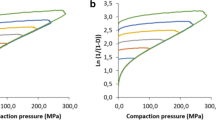Abstract
Moisture sorption characteristics and the effect of moisture content on the compression properties of two dextrose-based directly compressible diluents, namely, Emdex (diluent A) and Sweetrex (diluent B) were studied. Both diluents sorbed moisture rapidly at relative humidities greater than 60%. For both the diluents, pressures required to compress tablets to the same relative density decreased with increasing moisture content. Yield pressures calculated from linear Heckel plots obtained from the compression data of both diluents reflected decreasing values with increasing moisture content. Three-way surface profile graphs of moisture content versus tablet parameters such as crushing force, relative density, and compression pressure give a unique overall picture of the compression properties of a diluent and offer the tablet formulator a useful tool for diluent comparison.
Similar content being viewed by others
REFERENCES
E. Shotton and J. E. Rees. The compaction properties of sodium chloride in the presence of moisture. J. Pharm. Pharmacol. 18:160S–167S (1966).
E. T. Cole, P. H. Elworthy, and H. Sucker. Effect of moisture content on the physical properties of a starch granulation. J. Pharm. Pharmacol. 25: 1P (1973).
N. A. Armstrong and R. V. Griffiths. The effects of moisture on the flow properties and compression of phenacetin, paracetamol and dextrose monohydrate. Pharm. Acta Helv. 45:692 (1970).
S. Esezobo and N. Pilpel. Some formulation factors affecting tensile strength, disintegration and dissolution of uncoated oxytetracycline tablets. J. Pharm. Pharmacol. 28:8–16 (1976).
S. Esezobo and N. Pilpel. Moisture and gelatin effects on the interparticle attractive forces and the compression behavior of oxytetracycline formulations. J. Pharm. Pharmacol. 29:75–81 (1977).
Z. T. Chowhan and L. Palagyi. Hardness increase induced by partial moisture loss in compressed tablets and its effect on in vitro dissolution. J. Pharm. Sci. 67:1385–1389 (1978).
Z. T. Chowhan. Role of binders in moisture-induced hardness increase in compressed tablets and its effect on in vitro disintegration and dissolution. J. Pharm Sci. 69:1–4 (1980).
K. A. Khan, P. Musikabhuma, and J. P. Warr. The effect of moisture content of microcrystalline cellulose on the compressional properties of some formulations. Drug Dev. Ind. Pharm. 7(5):525–538 (1981).
Handbook of Pharmaceutical Excipients, American Pharmaceutical Association, Washington, D.C., 1986.
N. A. Armstrong and A. Patel. The compressional properties of dextrose monohydrate and anhydrous dextrose of varying water contents. Drug Dev. Ind. Pharm. 12(11–13):1885–1901 (1986).
N. A. Armstrong and A. Patel. The compression properties of dextrose monohydrate and anhydrous dextrose of varying moisture contents. In M. H. Rubinstein (ed.), Pharmaceutical Technology: Tabletting Technology, Vol. 1, Ellis Horwood, Chichester, England, 1987, pp. 127–138.
J. C. Price and Y. Pongpaibul. Effect of moisture content on the tabletting properties of sucrose-based direct compression excipients. Abstracts, 125th Annual Meeting of the American Pharmaceutical Association, Montreal, Canada, May 1978.
A. C. Rizzuto, A. C. Chen, and M. F. Veiga. Modification of the sucrose crystal structure to enhance pharmaceutical properties of excipient and drug substances. Pharm. Tech. 8(9):32–39 (1984).
R. W. Heckel. Density-pressure relationships in powder compaction. Trans. Metall. Soc. AIME 221:671–675 (1961).
R. W. Heckel. An analysis of powder compaction phenomena. Trans. Metall. Soc. AIME 221:1001–1008 (1961).
Z. T. Chowhan and Y. P. Chow. Compression properties of granulations made with binders containing different moisture contents. J. Pharm. Sci. 70:1134–1139 (1981).
Author information
Authors and Affiliations
Rights and permissions
About this article
Cite this article
Shukla, A.J., Price, J.C. Effect of Moisture Content on Compression Properties of Two Dextrose-Based Directly Compressible Diluents. Pharm Res 8, 336–340 (1991). https://doi.org/10.1023/A:1015889414533
Issue Date:
DOI: https://doi.org/10.1023/A:1015889414533




